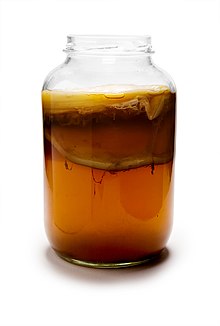tea dress中文(繁體)翻譯:劍橋詞典
Pretty tea dresses with colourful prints are one of this summer's trends. 有著鮮豔印花的漂亮茶歇裙,是今夏的流行款式之一。
Tea and Cha are both words from China, where the drink comes from. If it arrived in your country by sea, you'll probably call it "tea" or something similar--but if it was transported overland, it will be called something like "cha". Graphic from "India in Pixels"
印度市場開拓 日本茶加辣等香料
Be wary of applying stereotypes; not every youngster is sipping kombucha in a Brooklyn warehouse. Here’s a guide to marketing to the most prized consumers
紅茶菌,又名紅茶菇、茶菇、康普茶(Kombucha),因普遍在加糖的紅茶中培養而得名。紅茶菌不是單一的菌種,更不是菇類,經由分析其為酵母屬、醋桿菌屬和乳桿菌屬的共生物,其中以醋酸菌的含量最多。這種共生物英文稱爲SCOBY[1],代表的是Symbiotic Culture of Bacteria and Yeast。這些菌利用茶湯中的糖分及紅茶的單寧酸作為養分產生酒精與醋酸,顯微鏡下可看見桿狀的乳酸菌、醋酸菌和顆粒狀的酵母菌附著在一層薄膜上,若培養得宜會看見薄膜漸漸形成大朵菇狀的「茶菇」。紅茶菌飲料味道微酸,和發酵乳一樣是一種活菌飲品。[2]但這種飲品的功效曾被嚴重誇大。
康普茶多謠傳它源起西元前221年的中國,也有一說是西元414年韓國醫師為日本允恭天皇所帶去的療法,但美國康普茶專家Hannah Crum抱持懷疑的態度。台灣於60年代,就曾經流行過發酵,當時稱為「紅茶菇」,都是一般家庭自己發酵飲用,並未有大量生產及行銷販售。[3]
 Kombucha tea, including the culture of bacteria and yeast, which is not usually consumed | |
| Type | Flavored cold tea drink with fermentation byproducts |
|---|---|
| Country of origin | China |
| Alcohol by volume | <0.5% (commercial) |
| Proof (US) | <1 (commercial) |
| Color | Cloudy, commonly pale or dark brown and sometimes green |
| Flavor | Fermented, effervescent |
| Ingredients | Tea, sugar, bacteria, yeast |
| Variants | Fruit juices or spices added |
| Related products | Water kefir, Kefir, Kvass, Beer, Iced tea |
Kombucha (also tea mushroom, tea fungus, or Manchurian mushroom when referring to the culture; Latin name Medusomyces gisevii)[1] is a fermented, lightly effervescent, sweetened black tea drink commonly consumed for its purported health benefits. Sometimes the beverage is called kombucha tea to distinguish it from the culture of bacteria and yeast.[2] Juice, spices, fruit or other flavorings are often added.
Kombucha is thought to have originated in China, where the drink is traditional.[3][4] By the early 20th century it had spread to Russia, then other parts of Eastern Europe and Germany.[5] Kombucha is now homebrewed globally, and also bottled and sold commercially.[1] The global kombucha market was worth approximately US$1.7 billion as of 2019.[6]
Kombucha is produced by symbiotic fermentation of sugared tea using a symbiotic culture of bacteria and yeast (SCOBY) commonly called a "mother" or "mushroom". The microbial populations in a SCOBY vary. The yeast component generally includes Saccharomyces cerevisiae, along with other species; the bacterial component almost always includes Gluconacetobacter xylinus to oxidize yeast-produced alcohols to acetic acid (and other acids).[7] Although the SCOBY is commonly called "tea fungus" or "mushroom", it is actually "a symbiotic growth of acetic acid bacteria and osmophilic yeast species in a zoogleal mat [biofilm]".[1] The living bacteria are said to be probiotic, one of the reasons for the popularity of the drink.[8][9]
Numerous health benefits have been claimed to correlate with drinking kombucha;[10] there is little evidence to support any of these claims.[8][10][11] The beverage has caused rare serious adverse effects, possibly arising from contamination during home preparation.[12][13] It is not recommended for therapeutic purposes.[10][14]
Kombucha most likely originated in the Bohai Sea district in China.[4] The drink was consumed in Russia and from there entered the rest of Europe.[15] Its consumption increased in the United States during the early 21st century.[16][17] Having an alcohol content of less than 0.5%, kombucha is not a federally regulated beverage in the United States.[18][19]
Prior to 2015, some commercially available kombucha brands were found to contain alcohol content exceeding this threshold, sparking the development of new testing methods.[20] With rising popularity in developed countries in the early 21st century, kombucha sales increased after it was marketed as an alternative to beer and other alcoholic drinks in restaurants and pubs.[21]
According to Grand View Research,[clarification needed] Kombucha had a global market size of US$1.67 billion as of 2019 and this was expected to grow to US$2.4 billion by 2027.[6]
In Japanese, the term konbu-cha or kobu-cha (昆布茶, 'kelp tea') refers to a kelp tea made with powdered konbu (an edible kelp from the family Laminariaceae) and is a completely different beverage from the fermented tea usually associated with kombucha elsewhere in the world.
The etymology of kombucha is uncertain; however, it is speculated that it is a misapplied loanword from Japanese.[22] It has been hypothesized that English speakers mistook the Japanese word kombucha to mean fermented tea, when in fact, fermented tea in Japanese is called kōcha kinoko (紅茶キノコ, 'red tea mushroom').[23] Webster's Dictionary maintains that the use of kombucha in English likely stems from the misapplication of Japanese words: kombucha, kobucha 'tea made from kelp', kobu, konbu 'kelp', and cha 'tea'.[24] The American Heritage Dictionary offers further insight into the etymology of kombucha, stating that it was "perhaps ... used by English speakers to designate fermented tea due to confusion or because the thick gelatinous film produced by the kombucha culture was thought to resemble seaweed."[25]
The first known use in the English language of the word kombucha to describe "a gelatinous mass of symbiotic bacteria (as Acetobacter xylinum) and yeasts (as of the genera Brettanomyces and Saccharomyces) grown to produce a fermented beverage held to confer health benefits" was in 1944.[24]